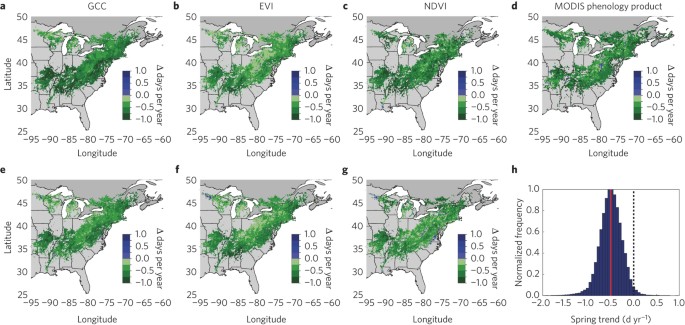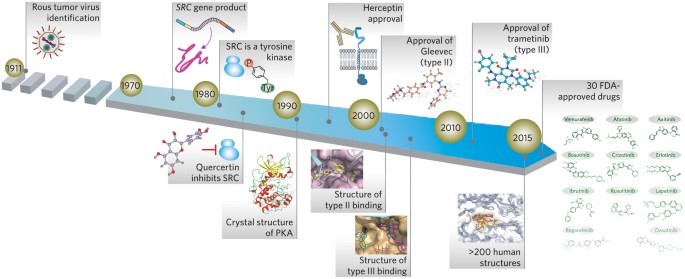
- Select a language for the TTS:
- UK English Female
- UK English Male
- US English Female
- US English Male
- Australian Female
- Australian Male
- Language selected: (auto detect) - EN
Play all audios:
ABSTRACT The timing of phenological events exerts a strong control over ecosystem function and leads to multiple feedbacks to the climate system1. Phenology is inherently sensitive to
temperature (although the exact sensitivity is disputed2) and recent warming is reported to have led to earlier spring, later autumn3,4 and increased vegetation activity5,6. Such greening
could be expected to enhance ecosystem carbon uptake7,8, although reports also suggest decreased uptake for boreal forests4,9. Here we assess changes in phenology of temperate forests over
the eastern US during the past two decades, and quantify the resulting changes in forest carbon storage. We combine long-term ground observations of phenology, satellite indices, and
ecosystem-scale carbon dioxide flux measurements, along with 18 terrestrial biosphere models. We observe a strong trend of earlier spring and later autumn. In contrast to previous
suggestions4,9 we show that carbon uptake through photosynthesis increased considerably more than carbon release through respiration for both an earlier spring and later autumn. The
terrestrial biosphere models tested misrepresent the temperature sensitivity of phenology, and thus the effect on carbon uptake. Our analysis of the temperature–phenology–carbon coupling
suggests a current and possible future enhancement of forest carbon uptake due to changes in phenology. This constitutes a negative feedback to climate change, and is serving to slow the
rate of warming. Access through your institution Buy or subscribe This is a preview of subscription content, access via your institution ACCESS OPTIONS Access through your institution
Subscribe to this journal Receive 12 print issues and online access $209.00 per year only $17.42 per issue Learn more Buy this article * Purchase on SpringerLink * Instant access to full
article PDF Buy now Prices may be subject to local taxes which are calculated during checkout ADDITIONAL ACCESS OPTIONS: * Log in * Learn about institutional subscriptions * Read our FAQs *
Contact customer support SIMILAR CONTENT BEING VIEWED BY OTHERS INCREASED CARBON ASSIMILATION AND EFFICIENT WATER USAGE MAY NOT COMPENSATE FOR CARBON LOSS IN EUROPEAN FORESTS Article Open
access 29 August 2022 SEASONAL WARMING RESPONSES OF THE CARBON DIOXIDE SINK FROM NORTHERN FORESTS ARE SENSITIVE TO STAND AGE Article Open access 21 January 2025 FOREST PRODUCTION EFFICIENCY
INCREASES WITH GROWTH TEMPERATURE Article Open access 21 October 2020 REFERENCES * Richardson, A. D. et al. Climate change, phenology, and phenological control of vegetation feedbacks to the
climate system. _Agricult. For. Meteorol._ 169, 156–173 (2013). Article Google Scholar * Wolkovich, E. M. et al. Warming experiments underpredict plant phenological responses to climate
change. _Nature_ 485, 494–497 (2012). Article CAS Google Scholar * Myneni, R., Keeling, C., Tucker, C., Asrar, G. & Nemani, R. R. Increased plant growth in the northern high latitudes
from 1981 to 1991. _Nature_ 386, 698–702 (1997). Article CAS Google Scholar * Barichivich, J. et al. Large-scale variations in the vegetation growing season and annual cycle of
atmospheric CO2 at high northern latitudes from 1950 to 2011. _Glob. Change Biol._ 19, 3167–3183 (2013). Article Google Scholar * Xu, L. et al. Temperature and vegetation seasonality
diminishment over northern lands. _Nature Clim. Change_ 3, 581–586 (2013). Article Google Scholar * Graven, H. D. et al. Enhanced seasonal exchange of CO2 by northern ecosystems since
1960. _Science_ 341, 1085–1089 (2013). Article CAS Google Scholar * Churkina, G., Schimel, D., Braswell, B. H. & Xiao, X. Spatial analysis of growing season length control over net
ecosystem exchange. _Glob. Change Biol._ 11, 1777–1787 (2005). Article Google Scholar * Dragoni, D. et al. Evidence of increased net ecosystem productivity associated with a longer
vegetated season in a deciduous forest in south-central Indiana, USA. _Glob. Change Biol._ 17, 886–897 (2011). Article Google Scholar * Piao, S. et al. Net carbon dioxide losses of
northern ecosystems in response to autumn warming. _Nature_ 451, 49–52 (2008). Article CAS Google Scholar * Richardson, A. D. et al. Influence of spring and autumn phenological
transitions on forest ecosystem productivity. _Phil. Trans. R. Soc. Lond. B. Biol. Sci._ 365, 3227–3246 (2010). Article Google Scholar * IPCC, _Climate Change 2013: The Physical Science
Basis. Contribution of Working Group I to the Fifth Assessment Report of the Intergovernmental Panel on Climate Change _ (ed Stocker, T. F.et al.) (Cambridge Univ. Press, 2013). * Aono, Y.
& Kazui, K. Phenological data series of cherry tree flowering in Kyoto, Japan, and its application to reconstruction of springtime temperatures since the 9th century. _Int. J. Climatol._
914, 905–914 (2008). Article Google Scholar * Primack, R. B., Higuchi, H. & Miller-Rushing, A. J. The impact of climate change on cherry trees and other species in Japan. _Biol.
Conserv._ 142, 1943–1949 (2009). Article Google Scholar * Thompson, R. & Clark, R. M. Is spring starting earlier? _The Holocene_ 18, 95–104 (2008). Article Google Scholar *
Miller-Rushing, A. J. & Primack, R. B. Global warming and flowering times in Thoreau’s Concord: A community perspective. _Ecology_ 89, 332–341 (2008). Article Google Scholar * Jeong,
S-J., Ho, C-H., Gim, H-J. & Brown, M. E. Phenology shifts at start vs. end of growing season in temperate vegetation over the Northern Hemisphere for the period 1982–2008. _Glob. Change
Biol._ 17, 2385–2399 (2011). Article Google Scholar * Delbart, N. et al. Spring phenology in boreal Eurasia over a nearly century time scale. _Glob. Change Biol._ 14, 603–614 (2008).
Article Google Scholar * Doi, H. & Takahashi, M. Latitudinal patterns in the phenological responses of leaf colouring and leaf fall to climate change in Japan. _Glob. Ecol. Biogeogr._
17, 556–561 (2008). Article Google Scholar * Dragoni, D. & Rahman, A. F. Trends in fall phenology across the deciduous forests of the Eastern USA. _Agricult. For. Meteorol._ 157,
96–105 (2012). Article Google Scholar * Ganguly, S., Friedl, M. A., Tan, B., Zhang, X. & Verma, M. Land surface phenology from MODIS: Characterization of the Collection 5 global land
cover dynamics product. _Remote Sens. Environ._ 114, 1805–1816 (2010). Article Google Scholar * Garrity, S. R. et al. A comparison of multiple phenology data sources for estimating
seasonal transitions in deciduous forest carbon exchange. _Agricult. For. Meteorol._ 151, 1741–1752 (2011). Article Google Scholar * Forkel, M. et al. Trend change detection in NDVI time
series: Effects of inter-annual variability and methodology. _Remote Sens._ 5, 2113–2144 (2013). Article Google Scholar * Archetti, M., Richardson, A. D., O’Keefe, J. & Delpierre, N.
Predicting climate change impacts on the amount and duration of autumn colors in a New England forest. _PLoS One_ 8, e57373 (2013). Article CAS Google Scholar * Cleland, E. E., Chuine,
I., Menzel, A., Mooney, H. a & Schwartz, M. D. Shifting plant phenology in response to global change. _Trends Ecol. Evol._ 22, 357–365 (2007). Article Google Scholar * Richardson, A.
D. et al. Terrestrial biosphere models need better representation of vegetation phenology: Results from the North American Carbon Program Site Synthesis. _Glob. Change Biol._ 18, 566–584
(2012). Article Google Scholar * Keenan, T. F. et al. Terrestrial biosphere model performance for inter-annual variability of land-atmosphere CO2 exchange. _Glob. Change Biol._ 18,
1971–1987 (2012). Article Google Scholar * Ballantyne, A. P., Alden, C. B., Miller, J. B., Tans, P. P. & White, J. W. C. Increase in observed net carbon dioxide uptake by land and
oceans during the past 50 years. _Nature_ 488, 70–72 (2012). Article CAS Google Scholar * Hufkens, K. et al. Ecological impacts of a widespread frost event following early spring
leaf-out. _Glob. Change Biol._ 18, 2365–2377 (2012). Article Google Scholar * Chuine, I. Why does phenology drive species distribution? _Phil. Trans. R. Soc. Lond. B. Biol. Sci._ 365,
3149–3160 (2010). Article Google Scholar * Buermann, W., Bikash, P. R., Jung, M., Burn, D. H. & Reichstein, M. Earlier springs decrease peak summer productivity in North American
boreal forests. _Environ. Res. Lett._ 8, 024027 (2013). Article Google Scholar * Richardson, A. D., Bailey, A. S., Denny, E. G., Martin, C. W. & O’Keefe, J. Phenology of a northern
hardwood forest canopy. _Glob. Change Biol._ 12, 1174–1188 (2006). Article Google Scholar * Desai, A. R. et al. Cross-site evaluation of eddy covariance GPP and RE decomposition
techniques. _Agricult. For. Meteorol._ 148, 821–838 (2008). Article Google Scholar * Elmore, A. J., Guinn, S. M., Minsley, B. J. & Richardson, A. D. Landscape controls on the timing of
spring, autumn, and growing season length in mid-Atlantic forests. _Glob. Change Biol._ 18, 656–674 (2012). Article Google Scholar * Hsiao, C. _Analysis of panel data_ (Cambridge
University Press, 2003). Book Google Scholar Download references ACKNOWLEDGEMENTS This research was supported by the NOAA Climate Program Office, Global Carbon Cycle Program (award
NA11OAR4310054) and the Office of Science (BER), US Department of Energy. T.F.K. acknowledges support from a Macquarie University Research Fellowship. A.D.R. acknowledges additional support
from the National Science Foundation’s Marcrosystem Biology program (grant EF-1065029). M.A.F. gratefully acknowledges support from NASA grant number NNX11AE75G S01. G.B. acknowledges the
National Science Foundation’s grant DEB-0911461. We thank all those involved in the NACP Site Synthesis, in particular the modelling teams who provided model output. Research at the Bartlett
Experimental Forest tower is supported by the National Science Foundation (grant DEB-1114804) and the USDA Forest Service’s Northern Research Station. Research at Howland Forest is
supported by the Office of Science (BER), US Department of Energy. Carbon flux and biometric measurements at Harvard Forest have been supported by the Office of Science (BER), US Department
of Energy (DOE) and the National Science Foundation Long-Term Ecological Research Programs. Hubbard Brook phenology data were provided by A. Bailey at the USDA Forest Service, Northern
Research Station, Hubbard Brook Experimental Forest. We thank D. Dragoni for useful comments on an earlier version of the manuscript. AUTHOR INFORMATION AUTHORS AND AFFILIATIONS * Department
of Biological Sciences, Macquarie University, Sydney, New South Wales 2109, Australia Trevor F. Keenan * Department of Organismic and Evolutionary Biology, Harvard University, Cambridge,
Massachusetts 02138, USA Trevor F. Keenan, Michael Toomey & Andrew D. Richardson * Department of Earth and Environment, Boston University, Boston, Massachusetts 02215, USA Josh Gray,
Mark A. Friedl & Ian Sue Wing * Department of Civil, Environmental & Geodetic Eng., The Ohio State University, Columbus, Ohio 43210, USA Gil Bohrer * USDA Forest Service, Northern
Research Station, Durham, New Hampshire 03824, USA David Y. Hollinger * School of Engineering and Applied Sciences and Department of Earth and Planetary Sciences, Harvard University,
Cambridge, Massachusetts 02138, USA J. William Munger * Harvard Forest, Petersham, Massachusetts 01366, USA John O’Keefe * Inst. of Meteorology and Climate Research, Karlsruhe Institute of
Technology, IMK-IFU, Garmisch-Partenkirchen 82467, Germany Hans Peter Schmid * Carbon Dioxide Information Analysis Center, Oak Ridge National Laboratory, Oak Ridge, Tennessee 37831, USA Bai
Yang Authors * Trevor F. Keenan View author publications You can also search for this author inPubMed Google Scholar * Josh Gray View author publications You can also search for this author
inPubMed Google Scholar * Mark A. Friedl View author publications You can also search for this author inPubMed Google Scholar * Michael Toomey View author publications You can also search
for this author inPubMed Google Scholar * Gil Bohrer View author publications You can also search for this author inPubMed Google Scholar * David Y. Hollinger View author publications You
can also search for this author inPubMed Google Scholar * J. William Munger View author publications You can also search for this author inPubMed Google Scholar * John O’Keefe View author
publications You can also search for this author inPubMed Google Scholar * Hans Peter Schmid View author publications You can also search for this author inPubMed Google Scholar * Ian Sue
Wing View author publications You can also search for this author inPubMed Google Scholar * Bai Yang View author publications You can also search for this author inPubMed Google Scholar *
Andrew D. Richardson View author publications You can also search for this author inPubMed Google Scholar CONTRIBUTIONS T.F.K. and A.D.R. designed the study and are responsible for the
integrity of the manuscript. A.D.R. planned the flux data analysis, with input from D.Y.H., J.W.M., G.B., H.P.S. and D.D. A.D.R., D.Y.H., J.W.M., G.B., H.P.S., B.Y., J.G., M.T. and J.O.K.
contributed data. T.F.K. compiled the data sets, and detailed and performed the analysis. M.A.F., I.S.W. and J.G. performed the panel analysis. T.F.K. led the writing, with input from all
other authors. All authors discussed and commented on the results and the manuscript. CORRESPONDING AUTHOR Correspondence to Trevor F. Keenan. ETHICS DECLARATIONS COMPETING INTERESTS The
authors declare no competing financial interests. SUPPLEMENTARY INFORMATION SUPPLEMENTARY INFORMATION (PDF 16915 KB) RIGHTS AND PERMISSIONS Reprints and permissions ABOUT THIS ARTICLE CITE
THIS ARTICLE Keenan, T., Gray, J., Friedl, M. _et al._ Net carbon uptake has increased through warming-induced changes in temperate forest phenology. _Nature Clim Change_ 4, 598–604 (2014).
https://doi.org/10.1038/nclimate2253 Download citation * Received: 28 October 2013 * Accepted: 17 April 2014 * Published: 01 June 2014 * Issue Date: July 2014 * DOI:
https://doi.org/10.1038/nclimate2253 SHARE THIS ARTICLE Anyone you share the following link with will be able to read this content: Get shareable link Sorry, a shareable link is not
currently available for this article. Copy to clipboard Provided by the Springer Nature SharedIt content-sharing initiative








